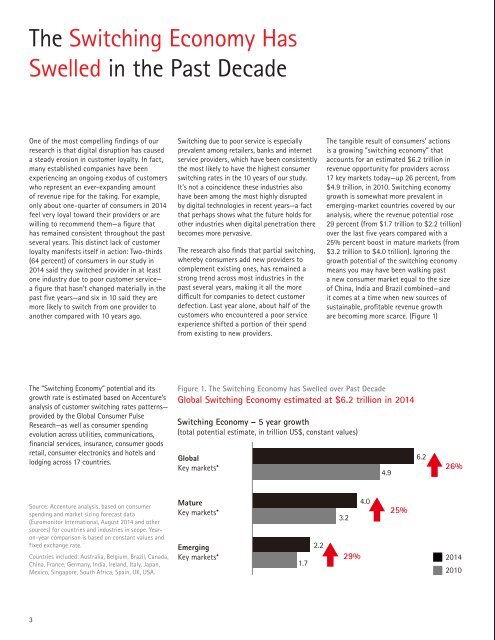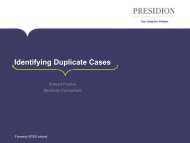Accenture-Customer-2020-Future-Ready-Reliving-Past
Accenture-Customer-2020-Future-Ready-Reliving-Past
Accenture-Customer-2020-Future-Ready-Reliving-Past
You also want an ePaper? Increase the reach of your titles
YUMPU automatically turns print PDFs into web optimized ePapers that Google loves.
The Switching Economy Has<br />
Swelled in the <strong>Past</strong> Decade<br />
One of the most compelling findings of our<br />
research is that digital disruption has caused<br />
a steady erosion in customer loyalty. In fact,<br />
many established companies have been<br />
experiencing an ongoing exodus of customers<br />
who represent an ever-expanding amount<br />
of revenue ripe for the taking. For example,<br />
only about one-quarter of consumers in 2014<br />
feel very loyal toward their providers or are<br />
willing to recommend them—a figure that<br />
has remained consistent throughout the past<br />
several years. This distinct lack of customer<br />
loyalty manifests itself in action: Two-thirds<br />
(64 percent) of consumers in our study in<br />
2014 said they switched provider in at least<br />
one industry due to poor customer service—<br />
a figure that hasn’t changed materially in the<br />
past five years—and six in 10 said they are<br />
more likely to switch from one provider to<br />
another compared with 10 years ago.<br />
Switching due to poor service is especially<br />
prevalent among retailers, banks and internet<br />
service providers, which have been consistently<br />
the most likely to have the highest consumer<br />
switching rates in the 10 years of our study.<br />
It’s not a coincidence these industries also<br />
have been among the most highly disrupted<br />
by digital technologies in recent years—a fact<br />
that perhaps shows what the future holds for<br />
other industries when digital penetration there<br />
becomes more pervasive.<br />
The research also finds that partial switching,<br />
whereby consumers add new providers to<br />
complement existing ones, has remained a<br />
strong trend across most industries in the<br />
past several years, making it all the more<br />
difficult for companies to detect customer<br />
defection. Last year alone, about half of the<br />
customers who encountered a poor service<br />
experience shifted a portion of their spend<br />
from existing to new providers.<br />
The tangible result of consumers’ actions<br />
is a growing “switching economy” that<br />
accounts for an estimated $6.2 trillion in<br />
revenue opportunity for providers across<br />
17 key markets today—up 26 percent, from<br />
$4.9 trillion, in 2010. Switching economy<br />
growth is somewhat more prevalent in<br />
emerging-market countries covered by our<br />
analysis, where the revenue potential rose<br />
29 percent (from $1.7 trillion to $2.2 trillion)<br />
over the last five years compared with a<br />
25% percent boost in mature markets (from<br />
$3.2 trillion to $4.0 trillion). Ignoring the<br />
growth potential of the switching economy<br />
means you may have been walking past<br />
a new consumer market equal to the size<br />
of China, India and Brazil combined—and<br />
it comes at a time when new sources of<br />
sustainable, profitable revenue growth<br />
are becoming more scarce. (Figure 1)<br />
The “Switching Economy” potential and its<br />
growth rate is estimated based on <strong>Accenture</strong>’s<br />
analysis of customer switching rates patterns—<br />
provided by the Global Consumer Pulse<br />
Research—as well as consumer spending<br />
evolution across utilities, communications,<br />
financial services, insurance, consumer goods<br />
retail, consumer electronics and hotels and<br />
lodging across 17 countries.<br />
Figure 1. The Switching Economy has Swelled over <strong>Past</strong> Decade<br />
Global Switching Economy estimated at $6.2 trillion in 2014<br />
Switching Economy – 5 year growth<br />
(total potential estimate, in trillion US$, constant values)<br />
Global<br />
6.2<br />
Key markets* 26%<br />
4.9<br />
Source: <strong>Accenture</strong> analysis, based on consumer<br />
spending and market sizing forecast data<br />
(Euromonitor International, August 2014 and other<br />
sources) for countries and industries in scope. Yearon-year<br />
comparison is based on constant values and<br />
fixed exchange rate.<br />
Countries included: Australia, Belgium, Brazil, Canada,<br />
China, France, Germany, India, Ireland, Italy, Japan,<br />
Mexico, Singapore, South Africa, Spain, UK, USA.<br />
Mature<br />
Key markets*<br />
3.2<br />
Emerging<br />
2.2<br />
Key markets* 29%<br />
1.7<br />
4.0<br />
25%<br />
2014<br />
2010<br />
3



